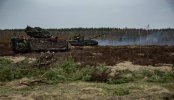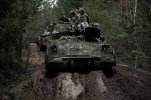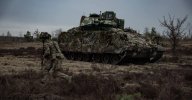Kiusankpl
Respected Leader
Kohta lähtee
Muoks viserrys ei näy, entäpä kuva siinä / Thomas C Theiner
https://twitter.com/noclador





Follow along with the video below to see how to install our site as a web app on your home screen.
Note: This feature may not be available in some browsers.
Kohta lähtee
Muoks viserrys ei näy, entäpä kuva siinä / Thomas C Theiner
https://twitter.com/noclador





Kuulostaa kovin neuvostodoktriinilta. Välineisiin on omaksuttu kertakäyttökulttuuri. Tämä puolestaan kertoo, ettei ukrainalaisilla ole käytössään tehokasta huoltoketjua. Välineet raavitaan huoltopisteisiin miten pystytään ja ehditään, jossa niitä sitten huolletaan luovasti soveltaen, kun ei ole toimivaa varaosalogistiikkaa. Eivät siis edes ymmärrä, mistä kehityksestä ovat jääneet paitsi 80 vuoden aikana.
"armies all try to have very few vehicles, but that is a cost-cutting measure dictated by pennypinchers in the finance ministries."
..sillä ainakaan kirjoittaja ei ymmärrä, mistä puhuu.
Maallikon silmiin näyttää puppugeneraattorin luomalta. Vaikkapa 33 mekanisoidun pataljoonien kaluson suhde näyttää omituiselta.Kohta lähtee
Muoks viserrys ei näy, entäpä kuva siinä / Thomas C Theiner
https://twitter.com/noclador

tämä perustuu jenkkien vuodettuihin asiakirjoihin joten lieneekin aika lähellä totuutta.Maallikon silmiin näyttää puppugeneraattorin luomalta. Vaikkapa 33 mekanisoidun pataljoonien kaluson suhde näyttää omituiselta.
Tuo vitjan kirjoittajan kommenttihan kalustokirjosta liittyi myös hänen huomioonsa mm. Israelin käymistä kahdesta sodasta, jossa AIVAN KAIKKI kalusto valjastettiin rintamalle. Myöhemmin sitten standartoitiin mitä voitiin.Taas toisaalta Ukraina on oikeasti käyttänyt saamaansa kalustoa sekä omaa vanhaa kalustoaan erittäin säästeliäästi, edelleen on paljon T-64:ia liikkeellä ja jopa ne harvinaiset T-84 Oplotit, edelleen on kaikki HIMARSit ja M270 toiminnassa, edelleen on valtaosa lännen luovuttamista tykeistä toiminnassa ja niitä pyritään suojaamaan kaikin mahdollisin keinoin. Lentokoneita on pidetty ilmassa todella vaikeasta tilanteesta huolimatta. Ei kannata kirjoittajasta vetää johtopäätöksiä vaan katsoa mitä siellä on oikeasti tapahtunut ja millainen tulos saavutettu lahjoitetulla kalustolla.
Viesti ehkä enemmänkin on, että eivät tee huollon monimutkaisuudesta laajalla kalustokirjolla ongelmaa vaan sitä voi murehtia sodan päättymisen jälkeen. Prioriteetit on oikein, ensin pitää voittaa ryssät, sen jälkeen voi miettiä kalustokirjon haittapuolia.
Ennemminkin voisi todeta, että jos nykyisellä kalustolla olisi suunnattomia vaikeuksia huollon järjestämisessä niin ei ehkä olisi järkeä lisätä sinne sekaan laajaa kirjoa länsimaisia tankkeja sekä muuta liikkuvaa monimutkaista vehjettä, mutta kun sellaista ongelmaa ei ole ollut niin ei sitä keksimälläkään tule.
Tässäkin asiassa tulos puhuu puolestaan eikä kannata kirjoitteluille laittaa liikaa painoarvoa. Ryssät hylkäävät kalustoa joka on siinä kunnossa, että ei liiku ja ukrainalaiset palauttavat niitä toimintakuntoinen. Eihän sen näin pitäisi olla kun toinen on tankkien suurvalta. Tai kuvittelee olevansa.





Ehtii islamisoitua ennen kuin demokratisoitua.mahtaako emäryssälästä kunnollista tulla ikinä..



Jahas, loppumattomat Armata lautat ovat lähteneet liikkeelle:

Venäläismedia: Venäjä lähettänyt kehittyneimpiä panssarivaunujaan Ukrainaan
Venäjän valtio-omisteisen uutistoimisto RIA Novostin mukaan Venäjä on lähettänyt Ukrainan taistelukentille kehittyneimpiä T-14 Armata -panssarivaunujaan.www.savonsanomat.fi
Ennen 24.2.2022 nämä olivat tulossa Suomeenkin putinistien sotafantasioissa sen jälkeen kun Suomen puolustusvoimat oli lamautettu Iskandereilla ja ilmavoimat ammuttu alas kaiken tappavan S-400 ohjuskuplan alla. Hassuja oli ajat, tosin osa uskoo näihin vieläkin


Huolto- ja pioneeriosat myös puuttuvat kokonaan. Voi tietysti olla tarkoituksella jätetty kaavioista pois, mutta ei se tuon ammattimaisuutta ja uskottavuutta lisää lainkaan.Maallikon silmiin näyttää puppugeneraattorin luomalta. Vaikkapa 33 mekanisoidun pataljoonien kaluson suhde näyttää omituiselta.

 wavellroom.com
wavellroom.com
The final, practical and mundane reason why T-14 Armata will not become a production tank is because there is no assembly line. All models to date have been assembled by hand (like luxury cars). A sum of 64 million roubles was reportedly allocated to build the assembly line. The plant shell and workshops were built but are empty. Contracts were signed but Western machine tools and other technology were never supplied due to sanctions (the same story has now unfolded with Russia’s moribund automotive industry facing an uncertain future with the departure of Western and Far Eastern car manufacturers). As many as 200 suppliers would need to be re-profiled. This will not happen now.
Se isoin risteysasema on Novobohdanivkassa (tjsp) vähän Tokmakista länteen päin. Siinä kohtaavat radat pohjoisesta Zaporitsiasta, idästä Donetskista, etelästä Melitopolista (ja Krimiltä) sekä lännestä Nova Kakhovkasta. Tokmakista itään on myös risteysasema, josta lähtee rata etelään Berdjanskiin.
Pehmitys käynnissä selvästi, samalla kuten Antares yllä toi esille, myös Tokmakissa paukkuu joka on tärkeä risteyskaupunki. Oliko täällä myös se junaradan risteys?
